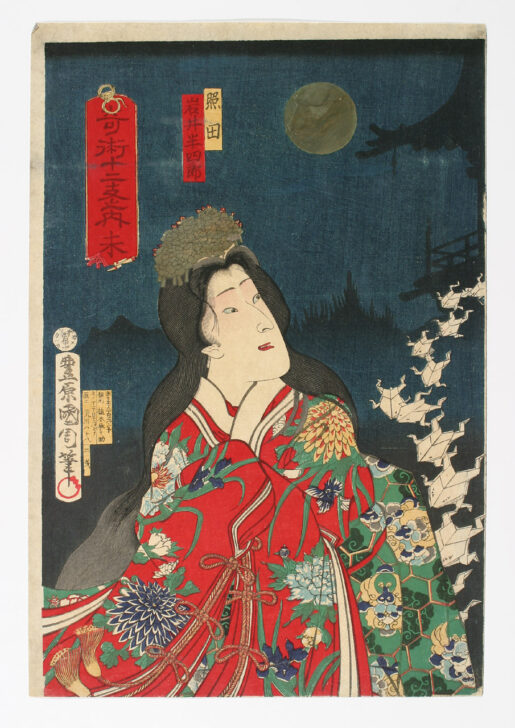Twelve Hours of Magic: Hour of the Sheep, Iwai Hanshirō VIII as Princess Teruta from The Heroic Tales of Jiraiya
Toyohara Kunichika

Description
In a scene that might have been directed by Alfred Hitchcock, origami frogs swarm to attack a beautiful young princess who has ventured out at night. Toyohara Kunichika gives an air of menace to what might have become comical in lesser hands, allowing the dark night to swallow everything but the princess, the full moon, and the eerily white frogs. A disciple of Utagawa Kunisada, Kunichika was the most prominent print designer to document the kabuki stage in the second half of the nineteenth century. Kunichika’s career coincided with the introduction of chemical dyes, which made possible the vivid colors seen here.
The star of this scene is Iwai Hanshirô VIII (1829–1882), an actor who had been performing female roles for forty-five years before he was promoted to the prestigious Hanshirô stage name in 1872. In the 1860s and 70s, he was the leading onnagata in Edo.
Maribeth Graybill, "Recent Acquisitions of East Asian Art," November 5, 2005-May 14, 2006
Subject Matter:
The Heroic Tales of Jiraiya is a fantastical story taking place in the province of Echigo in which the bandit Jiraiya learns magic in order to get revenge for his family’s murder. The paper frogs on the right side of the print may reference Jiraiya’s magic, which is the magic of the giant toad. The story was originally a serialized novel, first performed as a kabuki play in 1852.
Actor Iwai Kumesaburō III was also known as Iwai Hanshirō VIII. He was born in 1829 and active from the time he was a child in the early 1830s. He became famous for his performances as an onnagata, a word which means "female role" or "female form." He died in 1882.
Physical Description:
A woman clasps her hands in front of her, looking off to the side. She wears a red robe with large, colourful flowers. Her hair is loose underneath a cap of flowers. A line of paper frogs descends from a building in the upper right behind her. The moon and a mountain are visible behind her.
Inscriptions: Iwai Hanshirō, Shōden; Kijutsu jūnishi nouchi hitsuji (Title); Toyohara Kunichika hitsu (Artist's signature); Horiechō nichōme 2-banchi, hanmoto ueki Rinnosuke (Publisher's seal); Meiji 10 nen 2 gatsu 1nichi otodoke (Date)
Usage Rights:
If you are interested in using an image for a publication, please visit https://umma.umich.edu/request-image/ for more information and to fill out the online Image Rights and Reproductions Request Form.